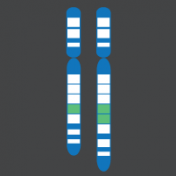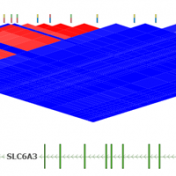Copy Number Variations (CNVs) play an important role in human health and disease, and the detection of CNVs in clinical samples has the potential to improve clinical diagnoses and inform treatment decisions. Yet until now, if you wanted to have CNVs on your targeted gene samples, you would need an alternative assay such as Chromosomal Microarrays (CMAs). In this webcast,… Read more »
Gabe Rudy’s webcast yesterday, Big Data at Golden Helix: Scaling to Meet the Demand of Clinical and Research Genomics, was a huge success with well over 300 registered. In today’s blog post, I wanted to recap the Q&A session with Gabe. If you missed the webcast, check it out! Question: What is the end goal for an application like Warehouse? Answer: The… Read more »
Any validated bioinformatics pipeline must be continuously monitored. Quality management in clinical testing labs ensures that any divergence from predefined quality metrics during the analysis of clinical samples is investigated. For example: There is an insufficient number of sequence reads that passed the predefined base quality score threshold The number of variants identified in a data set may deviate substantially… Read more »
Big data is here, but fear not, you don’t need a Hadoop cluster to analyze your genomes or your cohorts of tens of thousands of samples! It turns out, for the kind of algorithms employed in variant annotation and filtering, running optimized local programs is often faster anyway. As we support our diverse customer base, we have definitely seen the… Read more »
Pruning your data based on Linkage Disequilibrium (LD) values is an important quality assurance step for GWAS analysis. In particular, some tests such as Identity by Descent Estimation (IBD), Inbreeding Coefficient Estimation (f) and Principal Component Analysis (PCA) will obtain better results if the markers used are not in linkage disequilibrium with each other. Therefore, Golden Helix’s SVS provides the… Read more »
Wednesday, September 21st @ 12:00 pm EDT Every day, the trove of genomic data is growing. Clinics are sequencing targeted genes at high read depths to report out genetic tests. Research groups are adding new exomes and genomes to their disease-specific cohorts. Agricultural breeders are genotyping their herds and flocks by the thousands of thousands. The conventional attitude to big… Read more »
After the Wet Lab process has been completed, the bioinformatics analysis of the sequencing data work begins. The next three blogs will focus on three aspects of this process. The building blocks of a bioinformatics pipeline, documentation and validation (today’s topic) Quality Management Clinical Reporting The Building Blocks of an NGS PipelineThe bioinformatics process to analyze NGS data occurs in three… Read more »
Getting the NGS wet bench process right is not a small undertaking. Targeted NGS assays such as multigene panels or exome sequencing allow for the targeted analysis of genomic regions that are of particular interest. For every sample type, e.g. blood, formalin-fixed paraffin-embedded specimens, saliva etc, there must be a detailed protocol in place outlining how each sample type is going… Read more »
We have come a long way since Next-Generation Sequencing (NGS) evolved as a set of technologies in the 1970s. The higher throughput and rapid reduction of costs associated with NGS have lead to the accelerated adoption of clinical testing that we are experiencing today. Currently, it is applied to analyze inherited diseases, tumors, hematologic malignancies and infectious diseases. It is… Read more »
Join us for a guest presentation Personalized Medicine through Tumor Sequencing by Dr. Jeffrey Rosenfeld! Wednesday, September 7th 12:00 pm EDT The identification of medications that target specific gene mutations is one of the major recent advances in cancer therapy. In 2001 Gleevec was approved to treat patients with the BCR-ABL fusion in chronic myelogenous leukemia (CML). Since then many more drugs… Read more »
Question: Now that I’ve added annotation sources for my sample, filtered down to a list of interesting variants, flagged those variants and generated a clinical report, can I save or copy the annotation sources and filters for use on another sample? Short Answer: Yes! Long Answer: VarSeq was created with ease and efficiency in mind. In VarSeq, once you’ve defined… Read more »
The adoption of genetic services is key to our ability to provide personalized medicine in the future. The goal is to better diagnose diseases, predict their outcome, and choose the best possible care option for a patient. We still have a long way to go to achieve this goal. While there is agreement about the ultimate goal, there is still… Read more »
Dr. Rohan Palmer presents: Investigating Shared Additive Genetic Variation for Alcohol Dependence Wednesday, August 10th @ 12pm EDT Abstract: Molecular genetic research has supported the use of a multivariate phenotype representing alcohol dependence in studies of genetic association. One recent study found that additive genetic effects on Diagnostic and Statistical Manual of Mental Disorder version four (DSM-IV) alcohol dependence criteria overlap,… Read more »
Now available in SVS! Increasingly important in the analysis of the genotype to phenotype relationship is accurately accounting for the relatedness of samples. This is especially important to model correctly in plant and animal populations where man-directed breeding shapes the relationship structure. Along with trait association, one of the high-value use cases for genotyping animals and plants is to estimate… Read more »
We are excited to announce that earlier this month an article by our CEO, Dr. Andreas Scherer, was featured in Chronicle Pharmabiz. The article is focused on how Precision Medicine is becoming a reality by leveraging the advances in technology. The excerpt below is courtesy of Chronicle Pharmabiz. Almost 2,500 years ago, Hippocrates captured one of the key principles underlying… Read more »
Every month hundreds of clinicians and researchers access the variety of free resources on the Golden Helix website. Our resource library hosts eBooks, webcasts and tutorials to keep the community apprised of new methods, informed on best practices and to help our customers get the most out of their software purchase. Here is a list of the 5 most watched webcasts… Read more »
ClinVar is one of our most used annotations sources for a variety of workflows. It is also the public annotation source that is updated most frequently of all the sources currently supported in VarSeq. ClinVar provides new versions of their database once a month in several formats (XML, VCF, TXT). We use custom Python scripts to convert the provided VCF… Read more »
Since 1999, Bonei Olam has been providing large-scale funding for fertility treatment and research. The non-profit’s mission is to provide whatever means or resources necessary to help childless couples achieve the dream of parenthood. Today, it is recognized in the worldwide medical arena for its leadership role at the forefront of reproductive medicine, research and technology. Specifically, Bonei Olam has… Read more »
Variant Normalization: Underappreciated Critical Infrastructure It may surprise you to learn that every variant in the human genome has an infinite number of representations! Of course, although true, I’m being a bit hyperbolic to prove a point. Even seemingly simple mutations like single letter substitutions are legitimately represented differently in the local context of other mutations that can be described… Read more »
Upcoming Golden Helix Webcast: Using Clinical Reports as part of a Gene Panel Pipeline Wednesday, July 13th @ 12:00 pm EDT VarSeq Reports can be used as part of an automatic pipeline to quickly list variants with information that can be used to make actionable clinical decisions in a readable HTML format. Need to further filter the variants or add interpretation… Read more »

















